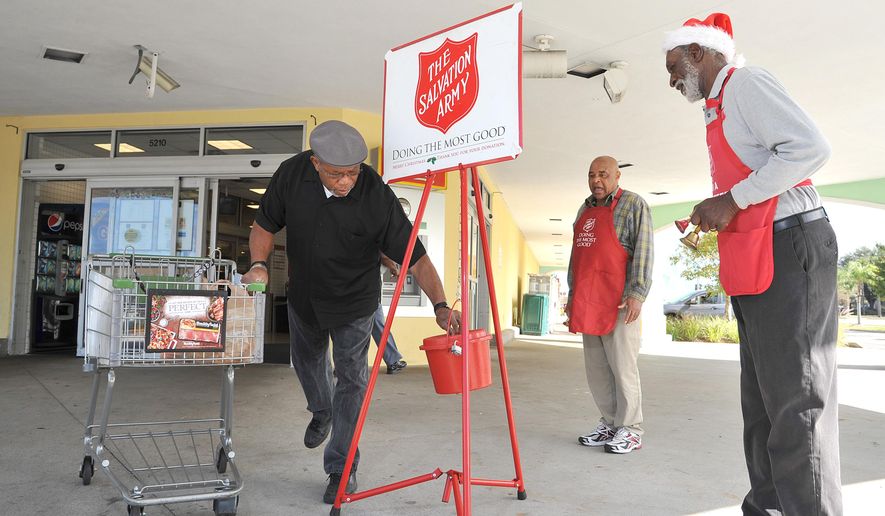Newly released data show that the religious among us are more likely to give to charities than those who do not identify with a faith tradition.
The data result from the Philanthropy Panel Study, an ongoing project at the University of Indiana’s Lilly Family School of Philanthropy that tracks U.S. household giving.
David King, director of the Institute on Faith & Giving at the school, said the “Giving USA Special Report on Giving to Religion,” released on Oct. 26 by The Giving Institute, reaffirms what many researchers in the field have long known: that there is a “substantial connection between religion and giving.”
“Religious affiliation really matters,” Mr. King said. “Someone with a religious affiliation was more than two times more generous than someone without a religious affiliation. And among those with a religious affiliation, religious intensity really matters. Those who attend services were much more likely to give, whether it’s monthly or weekly. We really see the connection grow with continued involvement in a religious community.”
Not surprisingly, religiously affiliated households are much more likely than nonreligious households to donate to religious institutions defined in the report as congregations, denominations, missionary societies and religious media.
But religious people also contribute to other types of charity at similar or higher rates than their secular counterparts.
The report says there is a “staggering difference between the charitable giving practices of the religiously affiliated and those with no religious affiliation.” While 62 percent of religious households give to charity, only 46 percent of nonreligious households do.
On average, religiously affiliated households donate $1,590 to charity annually, while households with no religious affiliation contribute $695.
And in 2016 religious institutions received more than twice as much charitable giving, $122.94 billion, as any other industry in the nonprofit sector. The next-highest category, education, received $59.77 billion in contributions.
Religious giving accounts for 32 percent of all U.S. charitable giving, the study found, but that number may underestimate the influence that religious belief has on charity. The study used a narrow definition of “religious giving” that does not include donations to faith-based nonprofits that provide human services, such as Catholic hospitals or universities.
Some studies, using a more expansive definition of “religious giving,” have estimated that faith motivates as much as 75 percent of all charity in the United States.
In addition to the tradition of giving in the Abrahamic faiths, Mr. King said religious institutions inspire people to donate to charity by fostering a sense of community.
“One is more likely to come across opportunities to engage, volunteer and to give of one’s time and money when one is involved in a faith community,” he said. “Faith communities matter,―community matters, and connection matters. It’s being with people in a voluntary association and a faith community or congregation that binds people together that helps them to see need — to want to engage and give of themselves.”
Although religious institutions continue to lead the way when it comes to charitable giving, there is some cause for concern.
A Chronicle of Philanthropy study released this month found that American giving is in decline. From 2000 to 2014 the share of American households donating to charity dropped by nearly 11 points, from 66.2 percent to 55.5 percent.
Robert Evans, president of the Evans Consulting Group, which is a member of The Giving Institute, said there are several phenomena that could explain dwindling rates of charitable giving, including penny-pinching inspired by the Great Recession, declining rates of religious affiliation and a dearth of charitable giving from millennials.
But he singled out massive student loan debt as the albatross around the neck of charity.
“Millennials are coming out of colleges and universities with enormous debt,” Mr. Evans said. “It has now become so expensive to get a college degree, it’s really difficult to come out debt-free. I think that is the 800-pound gorilla. I think everything else is ancillary.”
Indeed, the Giving USA report shows that cash-strapped millennials bring up the rear when it comes to charitable giving. Among all U.S. households, millennials only give $236 to religious institutions annually. On average, Gen Xers donate $617, baby boomers $1,082 and members of the “silent generation” $1,243.
Although the Philanthropy Panel Study does not compare millennial giving to that of older generations at the same age, other research has shown the up-and-coming generation is less charitable than its predecessors.
In order to maintain their level of charity, religious institutions need to be more intentional about the way they attract and retain donors, Mr. Evans said. Passing around the offering plate every service simply isn’t going to cut it anymore.
“Houses of worship are just starting to have either full-time or part-time in-house development professionals,” Mr. Evans said. “Clergy, up until recently, have had no formal training in fundraising. And houses of worship are obviously very dependent on voluntary giving.
“The system is changing,” he continued, “and houses of worship have been dragging their feet for far too long.”
• Bradford Richardson can be reached at brichardson@washingtontimes.com.




Please read our comment policy before commenting.